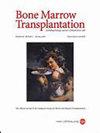外周血干细胞移植后用环磷酰胺调节:供体效应。
IF 4.5
2区 医学
Q1 HEMATOLOGY
引用次数: 0
摘要
氟达拉滨和美法兰(FM)调节提供有效的疾病控制与可接受的毒性概况。移植后环磷酰胺(PTCy)预防移植物抗宿主病(GVHD)改善移植结果。我们回顾性地回顾了在希望之城接受骨髓移植的PTCy患者。在纳入的248例患者中,89例(35.9%)接受了匹配的相关/非相关供体(MRD/MUD)的造血细胞移植(HCT), 118例(47.6%)接受了单倍相同(HID)供体的移植,49例(19.8%)接受了不匹配的非相关供体(MMUD)的移植。急性和慢性GVHD在供体类型上没有差异。接受HID、MMUD和MRD/MUD治疗的患者的2年总生存率(OS)分别为58%、55%和70%;无病生存率(DFS)分别为52%、48%和66%;移植物抗宿主/无复发生存率(GRFS)分别为48%、40%和59%。在多变量分析中,无论供体类型如何,OS、DFS和GRFS相似。然而,在所有患者的多变量分析中,无论供体类型如何,供体年龄≥35岁与较低的OS和GRFS以及较高的2年非复发死亡率(NRM)相关。在对供体进行调整后,PTCy的FM在MRD/MUD、MMUD和HID之间似乎产生了相似的结果本文章由计算机程序翻译,如有差异,请以英文原文为准。

Melphalan-based conditioning with post-transplant cyclophosphamide for peripheral blood stem cell transplantation: donor effect
Fludarabine and melphalan (FM) conditioning offers effective disease control with an acceptable toxicity profile. Post-transplant cyclophosphamide (PTCy) for graft-versus-host disease (GVHD) prophylaxis has improved transplant outcomes. We retrospectively reviewed patients receiving FM-based transplants with PTCy at City of Hope. Of 248 patients included, 89 (35.9%) received hematopoietic cell transplant (HCT) from a matched related/unrelated donor (MRD/MUD), 118 (47.6%) from a haploidentical (HID) donor, and 49 (19.8%) from a mismatched unrelated donor (MMUD). There were no differences in acute and chronic GVHD based on donor type. The 2-year overall survival (OS) for patients receiving HID, MMUD, and MRD/MUD was 58%, 55%, and 70%; disease-free survival (DFS) was 52%, 48%, and 66%; and graft-versus-host/relapse-free survival (GRFS) were 48%, 40%, and 59%, respectively. OS, DFS, and GRFS were similar regardless of donor type on multivariable analysis. However, donor age ≥35 years was associated with lower OS and GRFS and higher 2-year non-relapse mortality (NRM) on multivariable analysis across all patients, regardless of donor type. FM with PTCy appears to produce similar outcomes between MRD/MUD, MMUD, and HID when adjusting for donors <35 years, and donor age seems to be the most important factor when selecting a donor with this regimen.
求助全文
通过发布文献求助,成功后即可免费获取论文全文。
去求助
来源期刊

Bone Marrow Transplantation
医学-免疫学
CiteScore
8.40
自引率
8.30%
发文量
337
审稿时长
6 months
期刊介绍:
Bone Marrow Transplantation publishes high quality, peer reviewed original research that addresses all aspects of basic biology and clinical use of haemopoietic stem cell transplantation.
The broad scope of the journal thus encompasses topics such as stem cell biology, e.g., kinetics and cytokine control, transplantation immunology e.g., HLA and matching techniques, translational research, and clinical results of specific transplant protocols. Bone Marrow Transplantation publishes 24 issues a year.
 求助内容:
求助内容: 应助结果提醒方式:
应助结果提醒方式:


